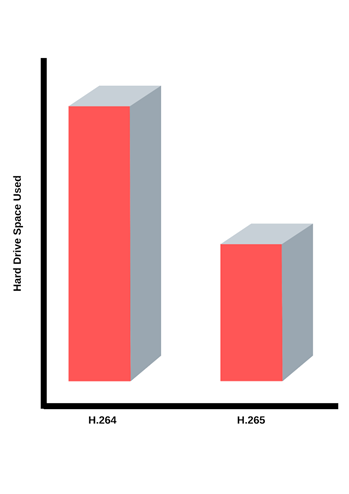|
What is H.264/H.265 Compression?
H.264/H.265 compression, essential technologies in the world of video compression, have significantly shaped the landscape of security and digital video recording. The advent of H.264 in 2003 marked a pivotal moment in the CCTV industry, as it emerged as the de facto standard for video compression. Unlike its predecessors, H.264 brought forth a revolutionary advantage - an exceptional compression ratio coupled with impeccable video quality, especially tailored for security applications. This technological leap not only conserved storage space but also extended recording durations on hard drives, owing to its superior compression capabilities. By achieving compression ratios up to twice as efficient as its forerunners, H.264 managed to bolster storage capacity significantly, translating into smaller file sizes and subsequently, lengthier recording periods on storage mediums.
One of H.264's remarkable feats is its ability to transmit high-quality images through networks while operating at remarkably low bit rates. This attribute becomes all the more significant in surveillance systems encompassing multiple cameras. Without the aid of efficient compression, such systems could easily overwhelm the available network bandwidth. As a result, legacy codec formats such as MPEG-4 and MJPEG gradually became obsolete, making way for the ascendancy of H.264 as the prominent codec in the realm of Digital Video Recorders (DVRs).
Fast forward to 2016, and the stage was set for another transformative innovation - H.265, which primarily found its application in IP NVRS and IP cameras. H.265, often referred to as High Efficiency Video Coding (HEVC), inherited all the formidable capabilities of H.264 while introducing a game-changing advantage: even more efficient data compression. The benefits of H.265, over its predecessor, were especially evident when it came to recording data onto hard drives. Utilizing an H.265-based Network Video Recorder (NVR) alongside IP cameras translated to storage savings of up to 40%. This remarkable compression prowess not only led to smaller file sizes but also extended recording durations on hard drives, surpassing even the gains achieved through H.264 compression.
A notable progression occurred in 2019 when the pioneering H.265 technology infiltrated the realm of DVRs, marking a significant expansion of its domain. The United Kingdom saw the inaugural release of DVRs equipped with H.265 capabilities during the early months of that year. The growing prevalence of high-resolution cameras, some boasting resolutions as high as 4K, forecasted the eventual obsolescence of H.264. Indeed, it was projected that H.264 would gradually fade from the scene by the culmination of 2019, further emphasizing the ascendancy of H.265 and its pivotal role in shaping the future of video compression technology.

|

